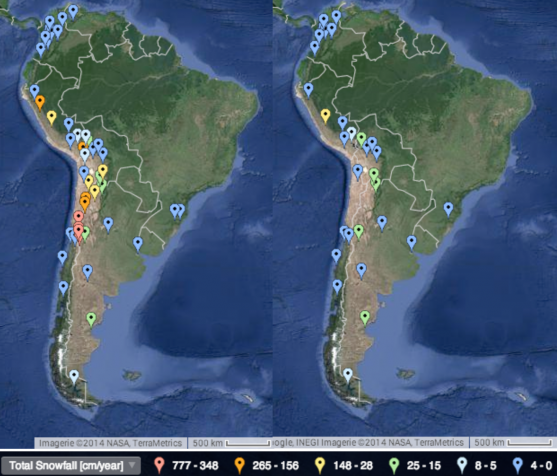Why studying the snow in South America?
South America has among the most populated cities in the world. The Andes, which extends from the equator until 60°S and whose highest peak, the Aconcagua, reaches 6,592m, have an important influence on the climate. Because temperatures depends both on latitude and elevation, it is not easy to know in which cities and how much does it snow. Nevertheless, this knowledge can be of importance for different fields, such as the management of transport systems.
Why using simulation data?
Weather simulation data from numerical models present the advantage to be accessible for any location that the model covers. With the meteoblue archive system it is easy to access the weather data of many locations and aggregate the values to obtain information on the climate.
What tools can we provide to show the results?
The best way to visualise the data is to plot the locations on a map and sort them by increasing snowfall amount.
In the frame of this example, we selected the cities regarding their size, latitude and elevation in order to sort the locations where it potentially snows and where it would have an impact. We add some peaks in the Andes in order to have an idea of some extreme values. The yearly averages are based on 5 years of continuous data.
The figure below shows the locations of interest sorted by increasing yearly snowfall (cm/year). The map on the left shows all the data points, whereas the right one just shows the cities (i.e without the mountains).

The first thing that we can see from this map is that there is practically no snow in Brazil, Venezuela and Colombia.
The second is that snowfall depends both on latitude and elevation: whereas it virtually never snows in Sucre, Bolivia (2,797 m a.s.l), snow is observed at sea level in the south of Argentina.
Finally, important zonal differences can be observed: whereas Mendoza has the highest yearly snowfall of all the selected cities, Santiago, just 200km westward on the other side of the Andes, does not get any snow.
What's next?
If you are interested in a more detailed study on this or another example you can contact us.
If you want information about the reliability of our simulation data, you can visit our verification page



